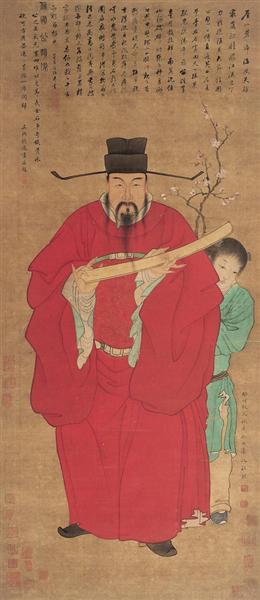
Yuan Dynasty (1271–1368)
Art movement
The Yuan dynasty (Chinese: 元朝; pinyin: Yuán Cháo), officially the Great Yuan (Chinese: 大元; pinyin: Dà Yuán; Mongolian: Yehe Yuan Ulus), was the empire or ruling dynasty of China established by Kublai Khan, leader of the Mongolian Borjigin clan. Although the Mongols had ruled territories including today's North China for decades, it was not until 1271 that Kublai Khan officially proclaimed the dynasty in the traditional Chinese style, and the conquest was not complete until 1279. His realm was, by this point, isolated from the other khanates and controlled most of present-day China and its surrounding areas, including modern Mongolia. It was the first foreign dynasty to rule all of China and lasted until 1368, after which the rebuked Genghisid rulers retreated to their Mongolian homeland and continued to rule the Northern Yuan dynasty. Some of the Mongolian Emperors of the Yuan mastered the Chinese language, while others only used their native language (i.e. Mongolian) and the 'Phags-pa script.
The Yuan dynasty is considered both a successor to the Mongol Empire and an imperial Chinese dynasty. It was the khanate ruled by the successors of Möngke Khan after the division of the Mongol Empire. In official Chinese histories, the Yuan dynasty bore the Mandate of Heaven, following the Song dynasty and preceding the Ming dynasty. The dynasty was established by Kublai Khan, yet he placed his grandfather Genghis Khan on the imperial records as the official founder of the dynasty as Taizu. In the Proclamation of the Dynastic Name, Kublai announced the name of the new dynasty as Great Yuan and claimed the succession of former Chinese dynasties from the Three Sovereigns and Five Emperors to the Tang dynasty.
In addition to Emperor of China, Kublai Khan also claimed the title of Great Khan, supreme over the other successor khanates: the Chagatai, the Golden Horde, and the Ilkhanate. As such, the Yuan was also sometimes referred to as the Empire of the Great Khan. However, while the claim of supremacy by the Yuan emperors was at times recognized by the western khans, their subservience was nominal and each continued its own separate development.
In 1271, Kublai Khan imposed the name Great Yuan (Chinese: 大元; pinyin: Dà Yuán; Wade–Giles: Ta-Yüan), establishing the Yuan dynasty. "Dà Yuán" (大元) is from the clause "大哉乾元" (dà zai Qián Yuán / "Great is Qián, the Primal") in the Commentaries on the Classic of Changes (I Ching) section regarding Qián (乾). The counterpart in Mongolian language was Dai Ön Ulus, also rendered as Ikh Yuan Üls or Yekhe Yuan Ulus. In Mongolian, Dai Ön (Great Yuan) is often used in conjunction with the "Yeke Mongghul Ulus" (lit. "Great Mongol State"), resulting in Dai Ön Yeke Mongghul Ulus (Mongolian script: ), meaning "Great Mongol State". The Yuan dynasty is also known by westerners as the "Mongol dynasty" or "Mongol Dynasty of China", similar to the names "Manchu dynasty" or "Manchu Dynasty of China" which were used by westerners for the Qing dynasty. Furthermore, the Yuan is sometimes known as the "Empire of the Great Khan" or "Khanate of the Great Khan", which particularly appeared on some Yuan maps, since Yuan emperors held the nominal title of Great Khan. Nevertheless, both terms can also refer to the khanate within the Mongol Empire directly ruled by Great Khans before the actual establishment of the Yuan dynasty by Kublai Khan in 1271.
This is a part of the Wikipedia article used under the Creative Commons Attribution-Sharealike 3.0 Unported License (CC-BY-SA). The full text of the article is here →
Wikipedia: https://en.wikipedia.org/wiki/Yuan_dynasty